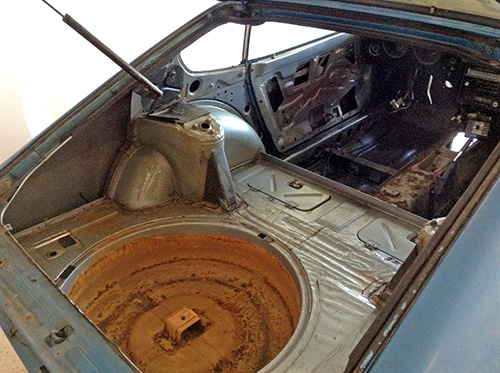Datsun 240Z Restoration: Dashless

The dash came out a few weeks ago with little drama. After unhooking the HVAC ducting and removing (what I thought) were all the fasteners, I disconnected the cables from the heater box and tried to pull it out. No dice. Turns out there are a pair of bolts at the very corners of the dash pad up near the base of the windshield that I had missed. These removed and a little elbow grease brought the whole assembly out the passenger door without much trouble.

Once out, I took out the heater box. Many of the flappers were rusted in place; will have to go over this, free them up and recondition. I removed the firewall insulation, fresh air ducts and hooked up the steering column again. The brake and clutch pedals and a few other things are attached to the column mounting bracket. Once it’s removed they’ll come down too.
All the car’s wiring harnesses converge behind the glovebox area, so it took a fair amount of labeling with blue tape to keep everything straight. I’ve been religious about keeping fasteners in labeled bags, but it occurred to me that I’ve been neglectful in simply keeping a record of the sequence in which components have been removed from the Z. Without this, it’s going to be a real mystery come reassembly time as far as what gets reinstalled first. Beyond the remaining few bits I need to remove under the rear of the car, my task now, before too much time passes, is to go over the car and remember the order in which I removed bits. Shouldn’t been too hard, and even if I’ve forgotten a thing or two, whatever I have should be a good guideline to go by.
Editor’s note: This post is Part 24 of an ongoing series chronicling my efforts toward the restoration of my 1972 Datsun 240Z, originally my father’s. Read the other installments here:
- Part 23: Gutting the Interior
- Part 22: The Teardown Begins
- Part 21: …And the Engine Comes Out
- Part 20: Treasure Hunting
- Part 19: Beginnings
- Part 18: VIN Discoveries
- Part 17: The Bad News
- Part 16: On The Road
- Part 15: Getting It Back On The Road
- Part 14: It Lives!
- Part 13: Restoring the Fuel System
- Part 12: Meat on the Wheels
- Part 11: Inspiration (Sort Of)
- Part 10: Carbs’ Return
- Part 9: First Triad Z Club Meet
- Part 8: Wheel Work
- Part 7: Tactical Changes
- Part 6: Little Things
- Part 5: Coming Home
- Part 4: The Rollout
- Part 3: Confessions of a Poor Car Enthusiast
- Part 2: Opening the Tomb
- Part 1: Projecting Forward





















